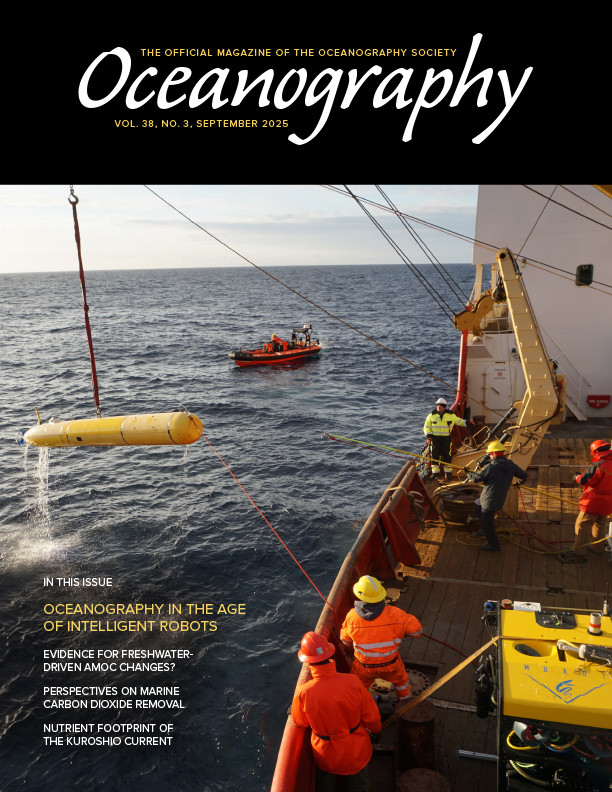Volume 38 | Number 3 | September 2025
On the Cover: A mapping autonomous underwater vehicle (AUV, left) is being recovered after a seafloor survey in Arctic waters. A portable remotely operated vehicle (MiniROV) is on the deck of Canadian Coast Guard Ship Sir Wilfrid Laurier. Image © 2016 MBARI
Cover PDF

About
![]()
Welcome to the September 2025 issue of Oceanography. Jump to the open access flipbook to page through the full issue. The flipbook version contains videos associated with Sholin's Figures 4, 6, 8, and 10, and animations associated with Xia et al.'s Figure 7. Scroll down this page to view the full set of individual articles.
CONTENTS
CONTENTS
QUARTERDECK • Enriching Readers’ Experience Through Oceanography Flipbooks
By
Ellen S. Kappel
COMMENTARY • Democratize the Data: A New Way to Analyze and Design Ocean Models
By
Thomas W.N. Haine
FEATURE ARTICLE • Is There Robust Evidence for Freshwater-Driven AMOC Changes? A Synthesis of Data, Models, and Mechanisms
By
Sophia K.V. Hines,
Nicholas P. Foukal,
Kassandra M. Costa,
Delia W. Oppo,
Olivier Marchal,
Lloyd D. Keigwin, and
Alan Condron
FEATURE ARTICLE • Perspectives on Marine Carbon Dioxide Removal from the Global Ocean Acidification Observing Network
By
Helen S. Findlay,
Richard A. Feely,
Kalina Grabb,
Elizabeth B. Jewett,
Elise F. Keister,
Gabby Kitch,
Yuri Artioli,
Punyasloke Bhadury,
Jeremy Blackford,
Odile Crabeck,
Anwesha Ghosh,
Yaru Li,
Kaitlyn B. Lowder,
Shreya Mehta,
Bryce Van Dam,
Houda Beghoura,
Noam Karo,
Andrij Z. Horodysky,
Sebastian Hennige,
Sally M. Salaah,
Federica Ragazzola, and
Liza Wright-Fairbanks
FEATURE ARTICLE • Nutrient Footprint from the Origin of the Kuroshio Current to the East China Sea Continental Shelf
By
Ting-Hsuan Huang and
Chen-Tung Arthur Chen
FEATURE ARTICLE • Mentors: The Hidden Beneficiaries of Mentoring
By
Mona Behl,
Sarah Clem,
Colleen Mouw,
Sonya Legg,
Erin Hackett,
Kristin Burkholder,
Kristopher B. Karnauskas,
Sarah T. Gille,
Lauren A. Freeman,
Karan Venayagamoorthy, and
Jerry L. Miller
ROGER REVELLE COMMEMORATIVE LECTURE • Oceanography in the Age of Intelligent Robots and a Changing Climate
By
Chris Scholin
MEETING REPORT • Tools in Harmony: Integrating Observations and Models for Improved Understanding of a Changing Ocean
By
Erica H. Ombres,
Heather Benway,
Kelsey Bisson,
Alyse A. Larkin,
Elizabeth A. Perotti,
Elizabeth Wright-Fairbanks,
Joey Crosswell,
Sandupal Dutta,
Cynthia Garcia,
Anand Gnanadesikan,
Kalina Grabb,
Amanda Fay,
Rui Jin,
Kyla Kelly,
Hayley Kwasniewski,
Alexa K. Labossiere,
Jonathan Lauderdale,
Jenna Lee,
Yajuan Lin,
Jacqueline S. Long,
Anna Rufas,
Cristina Schultz,
Nicholas D. Ward, and
Yifan Zhu
OCEAN EDUCATION • Drifter Challenge: A Low-Cost, Hands-On Platform for Teaching Ocean Instrumentation and Sensing
By
Charlene Xia,
Bianca Champenois,
Francisco Campuzano, and
Renato Mendes
THE OCEANOGRAPHY CLASSROOM • How To Get Factual Data and Articles: Surviving in Today’s Online World
By
Simon Boxall
CAREER PROFILES • CAREER PROFILES • Brian Kennedy
By
Brian Kennedy
CAREER PROFILES • CAREER PROFILES • Paige E. Martin
By
Paige E. Martin
